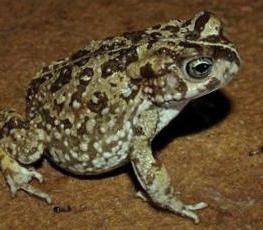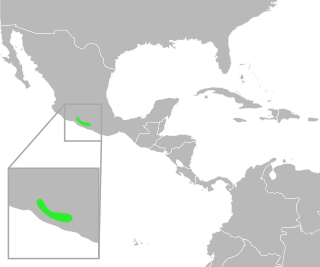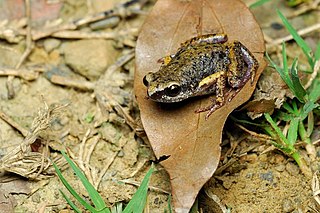
Microhyla ornata. commonly known as the ornate narrow-mouthed frog, ornate narrow-mouthed toad, or ornamented pygmy frog, is a species of microhylid frog found in South Asia. This amphibian is distributed in Kashmir, Nepal, peninsular India and the Andaman and Nicobar Islands, Sri Lanka, and Bangladesh. It was previously considered to be the same species as Microhyla fissipes; therefore, the aforementioned common names can refer to either species.

The sand toad, Cape sand toad, common Cape toad, or narrow-headed toad is a species of toad in the family Bufonidae. It is endemic to South Africa and found in southwestern and southern part of Western Cape Province to extreme southwestern Eastern Cape Province, from Nieuwoudtville in the west to Humansdorp in the east, along the coastal flats and Cape Fold Mountains from the sea level to 1,500 m (4,900 ft) asl.
The Beira toad, or Beira pygmy toad, is a species of toad in the family Bufonidae from southern Africa.

Sclerophrys blanfordii is a species of toad in the family Bufonidae. It is found in northeastern Ethiopia, northern Somalia, Djibouti, and Eritrea. The specific name blanfordii honours William Thomas Blandford, a British geologist and zoologist. Common names Blanford's toad and Ethiopia toad have been coined for it, the latter might specifically refer to the now-synonymized Bufo sibiliai.
Poyntonophrynus damaranus is a species of toad in the family Bufonidae. This species was previously known as Bufo damaranus, which is now considered a synonym. This anuran is endemic to Kaokoveld-Waterberg in area of northern and northwestern Namibia. The validity of this species has been questioned.
Poyntonophrynus dombensis is a species of toad in the family Bufonidae. It is found in southwestern Angola and northwestern Namibia.

The Karoo toad, Gariep toad, or mountain toad is a species of toad in the family Bufonidae found in southern Namibia, much of South Africa, Lesotho, and Eswatini. It is an abundant species that occurs in many types habitat: fynbos heathland, succulent karoo, thickets, grassland, and Nama Karoo. Breeding takes place in permanent and temporary waterbodies. There are no significant threats to this adaptable species.
Poyntonophrynus kavangensis is a species of toad in the family Bufonidae. It is found in Angola, Botswana, Namibia, Zimbabwe, and presumably Zambia. Its natural habitats are sandy areas of grasslands. It is associated with ephemeral pools and pans. It can breed in hypersaline pans.
Poyntonophrynus lughensis is a species of toad in the family Bufonidae. It is found in Somalia, northern and eastern Kenya, eastern, central and southern Ethiopia, and extreme southeastern South Sudan. Its natural habitat is very dry savanna. It breeds after the beginning of the rains in temporarily flooded hollows, including roadside ditches. The main threat to this species environmental degradation caused by human expansion and settlement, with increased populations of livestock as a consequence.
Poyntonophrynus parkeri is a species of toad in the family Bufonidae. It is found in central Tanzania and in southwestern Kenya, from the Usangu Plain in the south northward to the southern Great Rift Valley, Kenya. It is a poorly known species, however, and its distribution might be broader.

Incilius perplexus is a species of toad in the family Bufonidae. It is endemic to southern Mexico and found in the Tepalcatepec River basin in the Michoacán state and western Balsas River basin in Guerrero. Its natural habitats are seasonal tropical forests near streams. It breeds in pools. It is threatened by habitat loss caused by infrastructure development and agricultural expansion.
Mertensophryne taitana is a species of toad in the family Bufonidae. It is found in southeastern Kenya and southward through Tanzania to southeastern Democratic Republic of the Congo, northern Zambia, Malawi, and adjacent Mozambique. Its natural habitats are sandy places in woodlands, grasslands, open savanna, and agricultural fields. It is an opportunistic breeder utilizing small, temporary pools, and apparently, streams. The tadpole develop very fast, reaching metamorphosis in only 13 days. This adaptable species is not believed to face any significant threats.
Sclerophrys urunguensis is a species of toad in the family Bufonidae. It is found in the border area of Tanzania and Zambia, near the southeastern corner of Lake Tanganyika. One recent Tanzanian record is from close to the border with Burundi. Morphological characters suggests that it actually belongs to the genus Poyntonophrynus, but the formal move to that genus has not been made. Common name Urungu toad has been coined for it.
The Cape mountain toad or Rose's mountain toad is a species of toad in the family Bufonidae. Other common names include Rose's mountain toadlet, striped mountain toad, Rose's toad, and Muizenberg Cape toad. It is endemic to South Africa, where its natural habitat is Mediterranean-type shrubby vegetation known as fynbos. It is threatened by habitat loss.

The African tree toad is a species of toad in the family Bufonidae. It is found in the West and Central Africa from southwestern Nigeria through Cameroon to Equatorial Guinea, Gabon, and northeastern Democratic Republic of the Congo.
Bates's tree toad is a species of toad in the family Bufonidae. It is recorded in an area running from southern Cameroon to southwestern Gabon through southwestern Central African Republic to northeastern Democratic Republic of the Congo; it presumably occurs in Equatorial Guinea and Congo, and perhaps in Nigeria, but has not yet been recorded there. Its common and specific names commemorate George Latimer Bates (1863–1940), an American naturalist who traveled in West Africa.
Oreolalax rhodostigmatus is a species of amphibian in the family Megophryidae. It is endemic to central and south-central China where it can be found in Hubei, Sichuan, Guizhou, and Hunan provinces. While its distribution is relatively wide, it is known from only few locations. Its natural habitats are limestone caves in forested habitats. Breeding takes place in springs and stream pools inside the limestone caves. It is threatened by habitat loss and locally by collection for food (tadpoles).

Micryletta steinegeri is a species of frog in the family Microhylidae. It is endemic to central and southern Taiwan. In the past it has also been considered as a synonym of Micryletta inornata from continental Asia.
Amietia vertebralis, also known as Maluti river frog, aquatic river frog, ice frog, large-mouthed frog, or water frog, is a species of frogs in the family Pyxicephalidae. It is an aquatic high-altitude species found in Lesotho and adjacent South Africa.

Poyntonophrynus fenoulheti is a species of small toad found in southern Africa. It is known under many common names, including Fenoulhet's toad, Fenoulhet's pygmy toad, and northern pygmy toad. It grows to a maximum size of 43 mm.









